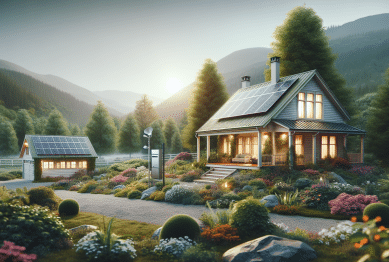Uncover how you can turn any backyard into a low-maintenance garden oasis, designed for beauty and practicality. This guide explores smart landscaping strategies, drought-tolerant plants, eco-friendly materials, and tips for simple upkeep. Get inspired to design a thriving space that fits your lifestyle and conserves resources.
Understanding Low-Maintenance Garden Design
Low-maintenance garden design is about creating outdoor environments that require minimal effort yet provide lasting enjoyment. Thoughtful planning around plant selection, layout, and practical features makes these gardens appealing for busy homeowners. Selecting native or drought-tolerant species, establishing clear pathways, and integrating efficient watering systems are hallmarks of success. The approach uses fewer resources, reduces ongoing maintenance, and enables anyone to enjoy a lush space without constant work. Strategic decisions made at the beginning can lead to years of stress-free gardening pleasure. Many find that removing high-maintenance lawns or swapping in perennial shrubs can dramatically cut labor and resource needs.
Planning is everything. Rather than a patchwork of random plants, a practical garden features organized zones: readymade beds for flowers or vegetables, shaded seating nooks, and defined walkways. Garden beds with thick mulch suppress weeds and keep moisture in the soil longer. Plants that naturally thrive in the area will need much less attention. Incorporating hardscape elements such as gravel paths or paver patios provides structure and further cuts down on chores. These details set the foundation for a holistic outdoor haven. With proper pre-planning, ongoing tasks like mowing or weeding are minimized, freeing up time for relaxation.
Embracing a low-maintenance style doesn’t mean sacrificing beauty. Some of the world’s most admired gardens use repetition of color, form, and texture to achieve harmony and visual interest. When paired with practical features like drip irrigation or automatic timers, these gardens can be both vibrant and sustainable. The design often celebrates naturalistic elements: curved beds, wildflower meadows, or dry creek beds. Not only do these elements save time, but they also offer crucial habitat for birds and pollinators. The right choices at the start influence both the environmental impact and maintenance load—making garden enjoyment the main event.
Smart Plant Choices for Easy Care
Selecting the right plants is central to any successful low-maintenance garden. Native species have adapted over generations to local soils, weather, and pests, so they require little intervention once established. Drought-tolerant perennials such as lavender, sedum, or Russian sage are favorites for sun-drenched spaces. Groundcovers like creeping thyme help keep weeds at bay while filling gaps with subtle color. Shrubs like boxwoods or hydrangeas can provide long-lasting structure without constant pruning or replacement. Choosing disease-resistant or pest-resistant varieties will save even more time and resources each season.
Mix it up for consistent interest. By blending evergreens, flowering perennials, and ornamental grasses, a low-maintenance garden gains texture and visual excitement throughout the year. For example, daylilies, coneflowers, and black-eyed Susans bloom readily with little help. The secret is to group plants with similar sun and water requirements, reducing the stress on each area. Avoiding water-hungry annuals or exotic species that need special care is key. With smart plantings, seasons transition gently from spring color to the muted tones of winter, all with minimal work required.
Plant placement makes a big difference. Position taller shrubs as windbreaks or living screens, and use low-growing varieties at pathway edges. Create layers for both beauty and efficiency, letting plants shade each other and suppress competing weeds. Many low-maintenance gardens also benefit from edibles like blueberries or herbs, which provide food without extensive tending. For those with limited space, container gardens with succulents, dwarf conifers, or herbs on patios can offer easy upkeep. Ultimately, choosing smart plant combinations sets up the garden to succeed with less intervention and more reliable beauty.
Efficient Watering and Mulching Strategies
Watering is one of the most demanding garden chores, but efficient systems make upkeep hassle-free. Drip irrigation and soaker hoses target roots directly, reducing evaporation and runoff. Simple programmable timers help maintain a steady schedule even when away from home. These techniques can be installed under mulch to further improve effectiveness. Rain barrels may capture runoff from roofs, providing a sustainable source for thirsty plants without spiking water bills. Every drop counts, especially in drought-prone regions where conservation is crucial for plant health and community resources.
Mulching is a game-changer for low-maintenance gardens. Applying two to four inches of organic mulch—such as shredded bark, straw, or compost—locks in moisture, insulates roots, and blocks weed growth. Over time, organic mulches break down and add nutrients to the soil, supporting long-term plant health. Inorganic mulches like gravel or stone offer similar benefits with less frequent replacement. Around walkways or near foundations, these materials reduce mud and soil erosion while creating crisp visual lines between planted beds and open spaces.
Combine watering and mulching strategies for best results. Many gardens suffer from overwatering or underwatering due to uneven distribution or shallow irrigation. Using mulch in tandem with deep, infrequent watering encourages deep root growth—making plants more drought-resistant and resilient. Smart technology like soil moisture sensors can further fine-tune irrigation. By creating a garden that retains moisture naturally and leverages rainwater, the need for constant manual watering nearly disappears. These strategies protect the environment and make it easier to keep the garden thriving season after season.
Pathways, Patios, and Practical Hardscaping
Hardscape features—walkways, patios, and border edges—form the backbone of a well-organized garden. Choosing materials like flagstone, decomposed granite, or permeable pavers makes for durable surfaces with minimal upkeep. These paths limit the spread of grass and weeds, encourage foot traffic where desired, and enhance the overall design. Raised beds with stone or recycled composite borders further reduce grass intrusion and make harvesting from vegetable or herb gardens less back-breaking. Integrated seating areas invite relaxation, understanding that ease is an essential feature of a welcoming garden oasis.
Practicality matters. When planning a low-maintenance garden, consider how people and tools will move through the space. Wide paths with gentle curves allow easy access for wheelbarrows and wheelchairs. Choosing materials that resist weathering, stains, and weeds means less annual repair or cleaning. Gravel options suppress weed growth and promote drainage, while brick paths offer classic appeal without complicated upkeep. Edging materials like metal or plastic strips help keep lawn grass out of beds and maintain tidy, defined spaces with very little maintenance needed.
Hardscaping also enables zone separation and creative visual interest. A patio with a pergola might serve as the garden’s centerpiece, flanked by low-care beds filled with native flowers and shrubs. Water features, like a simple birdbath, need only minimal cleaning when designed efficiently. Lighting—either solar or low-voltage LED—adds atmosphere and extends the garden’s usability into evening hours. Well-chosen hardscape features support plants, establish order, and minimize exhausting chores—helping any homeowner maximize their enjoyment of outdoor living spaces.
Sustainable and Eco-Friendly Choices
Sustainability is at the heart of modern low-maintenance garden design. By prioritizing native plants and reducing chemical inputs, gardens become part of a healthy ecosystem, supporting birds, pollinators, and beneficial insects. Compost bins or worm bins recycle kitchen and garden waste into rich soil amendments. This reduces landfill contributions and provides natural nutrients for plant growth. Xeriscaping, a landscaping method focused on water conservation, relies on drought-tolerant plants, efficient irrigation, and smart design to create resilient gardens. Eco-friendly practices keep maintenance simple while protecting the environment long-term.
Many gardeners now turn to integrated pest management, attracting predators like ladybugs or birds instead of using pesticides. Planting in layers—groundcovers, shrubs, overstory trees—mimics natural patterns, requiring less intervention and increasing biodiversity. Using locally sourced materials for pathways, patios, and mulch reduces transportation emissions and supports the local economy. Eco-friendly design isn’t only about reducing work; it’s about creating a space that feels harmonious and gives back to the landscape and community alike.
Simple strategies yield powerful results. Rotating crops in edible beds, letting leaves break down over winter as mulch, or planting clover for natural nitrogen fixation are easy to implement. Homeowners may be surprised how these actions reduce both costs and chores while improving yields and visual appeal. Sustainable, low-maintenance garden strategies help future-proof the garden, ensuring it adapts to changing climate or water conditions. By making a few intentional choices, anyone can enjoy an outdoor sanctuary that is both practical and planet-friendly.
Keeping Up With Minimal Effort
Even the most self-sufficient garden requires occasional attention, but simple routines keep it looking great with very little work. Regularly inspect for weeds and remove them quickly before they spread. Deadheading spent flowers encourages more blooms and prevents self-seeding of unwanted varieties. Every few weeks, a light pruning session keeps shrubs tidy and pathways clear. By doing small tasks as needed, rather than letting chores build up, garden maintenance feels manageable and satisfying.
Seasonal cleanups are an opportunity to refresh mulch, check irrigation systems, and tidy any hardscape areas. Early spring and late autumn are ideal for bigger jobs, such as planting, dividing overgrown perennials, or topping up gravel paths. Many gardeners find that investing ten minutes a day—even just picking up leaves or sweeping a path—makes a major difference in overall upkeep. The goal is to establish a relaxing environment, not a second job. Smart planning and handy tools reduce heavy labor and keep maintenance tasks enjoyable.
Over time, the garden matures and needs even less intervention. Perennials fill out, weeds become rare, and mulch settles into a stable layer. Automatic irrigation, native plantings, and no-fuss hardscaping together create lasting ease. Enjoying a low-maintenance garden oasis is about balance: choosing features and plants that suit the site, working with nature, and savoring the rewards. With a few minutes each week, the garden can remain a peaceful, welcoming retreat for years ahead.
References
1. United States Environmental Protection Agency. (n.d.). Water-Smart Landscapes. Retrieved from https://www.epa.gov/watersense/water-smart-landscapes
2. Royal Horticultural Society. (n.d.). Low-maintenance Gardening. Retrieved from https://www.rhs.org.uk/garden-jobs/low-maintenance-gardening
3. The University of California Master Gardener Program. (n.d.). Drought Tolerant Landscaping. Retrieved from https://ucanr.edu/sites/UrbanHort/Water_Efficient_Landscaping/Drought_Tolerant_Gardens/
4. National Wildlife Federation. (n.d.). Certified Wildlife Habitat. Retrieved from https://www.nwf.org/certify
5. Colorado State University Extension. (n.d.). Mulches for Home Grounds. Retrieved from https://extension.colostate.edu/topic-areas/yard-garden/mulches-for-home-grounds-7-214/
6. Xerces Society for Invertebrate Conservation. (n.d.). Sustainable Gardening. Retrieved from https://www.xerces.org/sustainable-gardening









